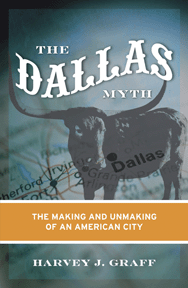He applied the “Page 99 Test” to his latest book, The Dallas Myth: The Making and Unmaking of an American City, and reported the following:

Page 99:Learn more about The Dallas Myth at the University of Minnesota Press website.
Chronology and conceptualization work together. Defining chronological periods requires us to place myriad discrete events in broader context, attending to processes of change, and enables useful comparisons over time and with other places. Dallas looks different from the perspective of 160 years than one of 80 years or less. Neither changes nor continuities, the sweep of the local, regional, or global, come into clear focus when the lens is too narrow and the frame too close.
From the time of its permanent settlement, Dallas always has been an urban place, a metropole at a crossroads located within an expanding regional, national, and international network. A great deal of Dallas’s history is encapsulated by a series of stages of urban development: from crossroads settlement to county town and service center for a prosperous agricultural region; chartered city, administrative, financial, industrial and, at times, labor center; and metropolitan center, gaining in size, influence, complexity, and diversity. Especially important and glaringly absent from existing accounts are the relationships of those stages or periods to each other, the interplay and influence of successive presents and futures on how we construct their pasts.
Dallas’s history highlights the transformation of the market from a place to an all‑pervasive form of political and cultural as well as economic power. Urban from its conception, the city is a fascinating example of self‑promotion. Exaggerated presumptions of Dallas’s autonomy and misconceptions of history as destiny have long blocked observers from placing the city in appropriate historical context, illuminating such themes as colonization, territorial expansion, slavery, agricultural development, commercialization, migration, and innovations in transportation. Dallas was born on the cusp of world‑making phenomena. Along with other U.S. cities, Dallas was a “gateway to the West,” a site on the “urban frontier.”
Historian Stuart Blumin explains two paths of city development. “In some countries, most notably the United States, much town formation must be attributed to territorial expansion”; the other scenario for city development, often erroneously assumed to be universal, is “the continuing development of long‑settled regions.” Many towns, including Dallas, “sprang not from farming communities but from forts, trading posts, and even the wilderness itself—at fords, at railway junctions, at sites arbitrarily selected as the seats for county government, and at seemingly random points on the faceless prairie, purchased, platted and promoted by the luckier or more skillful of the thousands of speculators who hoped to make their fortunes out of frontier urban development.”
--------------
As luck has it, page 99 represents the book’s narrative and arguments remarkably well. A more extended summary reads:
The ninth largest city in the United States, Dallas is exceptional among American cities for the claims of its elites and boosters that it is a “city with no limits” and a “city with no history.” Home to the Dallas Cowboys, self-styled as “America’s Team,” setting for the television series that glamorized its values of self-invention and success, and site of the assassination of John F. Kennedy, Dallas looms disproportionately large in the American imagination. Yet it lacks an identity of its own.
In The Dallas Myth, I present a novel interpretation of a city that has proudly declared its freedom from the past. I scrutinizes the city’s origin myth and its governance ideology, known as the “Dallas Way,” looking at how these elements have shaped Dallas and served to limit democratic participation and exacerbate inequality. Advancing beyond a traditional historical perspective, I propose an original, integrative understanding of the city’s urban fabric and offer an explicit critique of the reactionary political foundations of modern Dallas: its tolerance for right-wing political violence, the endemic racism and xenophobia, and a planning model that privileges growth and monumental architecture at the expense of the environment and social justice. Rather than being “different” from most large American cities, Dallas stands in an exaggerated frame.
Revealing the power of myths that have defined the city for so long, I present a new interpretation of Dallas that both deepens our understanding of America’s urban landscape and enables its residents to envision a more equitable, humane, and democratic future for all. Among the lessons is that myth carries great transforming force, regardless of its accuracy or distortion.
Visit Harvey J. Graff's faculty webpage.
--Marshal Zeringue



